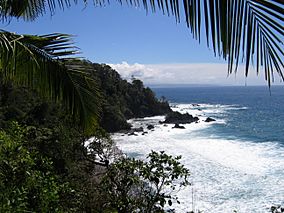Isla del Caño facts for kids
Quick facts for kids Caño Island Biological Reserve |
|||||||||||||||||||||||
|---|---|---|---|---|---|---|---|---|---|---|---|---|---|---|---|---|---|---|---|---|---|---|---|
| Reserva Biológica Isla del Caño | |||||||||||||||||||||||
|
IUCN Category Ia (Strict Nature Reserve)
|
|||||||||||||||||||||||

View from Caño Island
|
|||||||||||||||||||||||
| Location | Costa Rica | ||||||||||||||||||||||
| Area | 3.26 square kilometres (1.26 sq mi) (terrestrial), 52.01 square kilometres (20.08 sq mi) (marine) | ||||||||||||||||||||||
| Established | 30 September 1976 | ||||||||||||||||||||||
| Governing body | National System of Conservation Areas (SINAC) | ||||||||||||||||||||||
|
|||||||||||||||||||||||
| Location | Isla del Caño Osa Costa Rica |
|---|---|
| Coordinates | 8°42′22.1″N 83°53′23.1″W / 8.706139°N 83.889750°W |
| Year first constructed | 1940 (first) |
| Construction | steel skeletal tower |
| Tower shape | square pyramidal skeletal tower |
| Markings / pattern | red lantern |
| Height | 22 metres (72 ft) |
| Focal height | 63 metres (207 ft) |
| Range | 12 nautical miles (22 km; 14 mi) |
| Characteristic | Fl W 4s. |
Caño Island (Spanish: Isla del Caño) is a small island and special protected area in Costa Rica. It is located in the Pacific Ocean, about 10 kilometers (6 miles) west of the Osa Peninsula. The island rises steeply from the sea to a flat top, reaching a height of about 123 meters (404 feet).
Contents
Caño Island Biological Reserve
The Caño Island Biological Reserve (Spanish: Reserva Biológica Isla del Caño) is a protected area in Costa Rica. It was created in 1976 to help protect the amazing nature found there. This reserve includes both the island itself and a large area of the ocean around it, covering about 52 square kilometers (20 square miles).
Protecting Marine Life
The reserve has a special ranger station on the island. This helps protect the area and its wildlife. It's a very popular place for tourists who love nature, especially for activities like whale watching. People also visit to enjoy the beautiful beaches and explore the colorful coral reefs.
Scientists study the coral reefs here to learn more about how corals grow and how they recover if they get damaged. The ocean around Caño Island is full of incredible marine animals. You might see:
- Manta rays
- Dolphins
- False killer whales
- Sea turtles
- Many different kinds of fish
- Large whales
- Possibly even manatees
A unique sea slug, called Mexichromis tica, was first discovered here and near Darwin Island in the Galápagos Islands in 2004.
Terrestrial Life
While the ocean around Caño Island is very diverse, the land part of the island has fewer types of animals. For example, it has less than one percent of the insect types found on the nearby mainland. Many animals common on the mainland are not found on the island.
Archaeology and Ancient History
Caño Island has some exciting clues about people who lived there a very long time ago, even before Christopher Columbus arrived. One of the most interesting things found on the island are mysterious stone spheres. These perfectly round stones were carved by early civilizations. Scientists are still trying to understand exactly how and why these amazing spheres were made.
See also
 In Spanish: Isla del Caño para niños
In Spanish: Isla del Caño para niños


